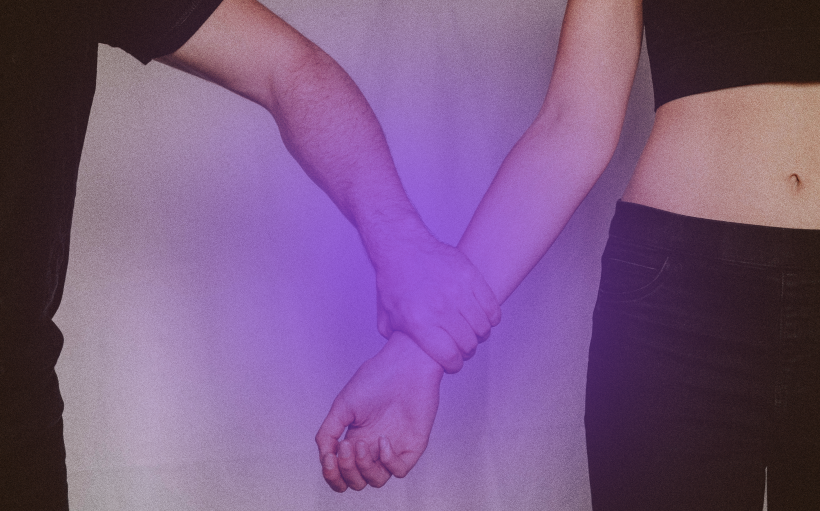After a devastating relationship breakup, I threw myself into the dating scene by registering on Hily. I had over 100 dates - some absolute disasters, some pretty average, and some that were actually great. So many stories to tell and insights to share with you guys!
What Is a PDA Relationship?
Are you that couple who can’t keep their hands off each other and have to display their affection to the rest of the world? Congrats then – you are in a PDA relationship! That’s the brand-new term characterizing the relationships that are based on public displays of affection. But that’s not the answer you’ve been searching for, ha? Do you want to know what is PDA relationship for real?
If so, check out this post. It has all the answers – and in great detail.
What Is PDA Relationship?
A PDA relationship is what you may find when you wish to be in a relationship that has more obvious displays of affectionate behaviors.
But what is PDA relationship? Simply put, PDA is an acronym that stands for public display of affection. Therefore, when you ask what is PDA relationship, the answer is a relationship in which you participate in public displays of affection toward your partner.
Although it is a term that is normally reserved for romantic couples, public displays of affection can be seen in almost any kind of relationship, from hugging or high-fiving friends to kissing your children and telling them that you love them. Showing affection of any kind in a public setting is considered to be PDA. But that raises doubt whether it’s a really deep and meaningful romantic relationship.
3 Common Misconceptions About PDA
What is PDA relationship? This is a question we have gone over multiple times in this article, and while we have talked about the good and the bad when it comes to PDA with your partners, we should also talk about the misconceptions that many have when it comes to public displays of affection.
Common myths about PDA:
- PDA is always sexual or inappropriate. While this can be true for certain levels of PDA, most of the time, it is very light touches and kisses that are often unnoticed by others.
- PDA only happens in newer relationships. Again, this is false as we find that those in newer relationships tend to be a bit more conservative as they are more aware. Inappropriate levels tend to start happening when things are somewhat more established.
- When partners don’t participate in PDA, there is something wrong in their relationship. Wrong again. PDA is completely suggestive, and what seems to be the perfect amount for some can be too much for others.

3 Ways You Can Tell If You Are In a PDA Relationship
Your partner may occasionally make a public display of affection towards you, but that doesn’t necessarily mean that you are in a PDA relationship. So what is PDA relationship, and how can you tell if you are in one?
The short answer is that in a PDA relationship, the public displays of affection are consistent and happen almost any time you are out in public settings with your partner. Here are just a few examples of public displays of affection, from holding hands to blowing kisses to your partner.
1. Physical Touch
“A human touch is explosive. It’s so warm that it melts away everything, including our ego.”
Uday Mukerji, writer
Physical affection is one of the most common ways people use to display public forms of affection. This physical contact can include multiple types of touch at multiple levels, some being more socially acceptable than others:
- holding hands,
- hugging each other,
- indulging in a kiss,
- sitting on your partner’s lap,
- snuggling with each other.
These are just a few forms of physical affection anyone can display in a romantic relationship.
Related reading: Understanding Physical Touch Love Language
2. Verbal Affirmations of Affection
When thinking about what is PDA relationship, it’s common to think about the physical contact-based forms of affection. After all, because of human behavior, it is easier to see those as PDAs.
However, nonphysical but verbal forms of affection can also be public displays of affection that show off your relationship status:
- Saying “I love you” out loud to your partner
- Telling your partner how cute, beautiful, or handsome they look
- Whispering in their ears
All of these are excellent examples of public displays of affection.
Related reading: Words of Affirmation – How to Make Them Into Love Language?
3. Verbal and Physical Forms of Affection
When it comes to public displays of affection, there are forms of it that aren’t verbal or physical. Silent and hidden ways that somehow tell the whole world of your love for each other:
- blowing kisses to your partner,
- winking at them,
- gazing into their eyes.
These just prove that a public display of love and affection doesn’t have to be anything that involves touch, like holding hands or engaging in a passionate kiss. Sometimes, it just needs a young couple who is hopelessly and silently in love.
Related reading: How to Know If You Are a Hopeless Romantic
4 Benefits of a PDA Relationship
What is PDA relationship and are there many benefits of being in one? Sometimes, it can be easy to focus on the negative context of PDA as it can make others feel uncomfortable.
But let’s be positive. The research shows these positive outcomes can come from PDA in a relationship:
- Stronger intimacy: Those who participate in hand-holding in public spaces, kissing, and other forms of PDA strengthen the sense of intimacy between each other. After all, PDA means to show how much they love each other publicly. By allowing yourself to engage in intimate and affectionate acts, you express your affection and increase that intimate bond.
- Less stress and anxiety: With a public display of affection as your comfort zone, you mitigate feelings of anxiety and give yourself a sense of security.
- Better bonding: PDA helps to open communication and develop trust and support, which results in a stronger bond with each other.
- Breaking taboos: In some environments, PDA helps to break the stigma that showing affection to your partners in public is inherently bad or weird. That is a liberating feeling.
2 Negative Impacts in a PDA Relationship
“If I could avert my eyes from all the kissing people ever, I’m positive that my life would be at least 2 percent more fulfilling.”
Julie Murphy, writer
When you ask yourself what is PDA relationship, you may notice that the very notion makes you feel uncomfortable and causes some negative thoughts. Thus, it will be fair to show a couple of potential drawbacks of a PDA relationship:
- PDA can potentially harm your reputation: This disadvantage may be based on culture, the way your parents brought you up, or your previous relationship experience. Unfortunately, PDA can easily be taken out of context, documented, and shared with others.
- PDA can highlight your differences with a partner: Your idea of a good PDA could be something along the lines of holding hands with each other or hugging them. But your partner’s idea of a PDA could be something a bit more intimate.
There are different circumstances and different types of PDAs that you and your partner can participate in. It’s generally a good thing to engage in – however, depending on the context, it can have a distinct effect on your relationships.

What Does PDA Say About Your Relationship?
Here are 4 PDA-based relationship types and how you can tell how long a couple has been together by the types of PDA they show in their relationship. Note that our example can range from a short-term healthy relationship to some type of insecure long-term relationships. That’s because PDA stands for the intensity of an emotional bond, not the relationship itself.
1. Early Stages of a Relationship
In new relationships, PDA may be a bit on the conservative side. Holding hands with each other or giving a quick kiss in a not-so-private place. This kind of PDA is deemed to be the most socially acceptable.
What this says about your relationship? You are excited to be around each other. You enjoy being together at social gatherings and you want to be showing affection to each other in small ways. Therefore, the hand holding and the quick peck or two that you partake in with each other is a great way to start the relationship.
2. Secure Relationship
In a secure relationship, you and your partner both love PDA because you can showcase them easily. But at the same time, you don’t feel the need to make a show out of it or make others feel uncomfortable. You enjoy being able to hold hands or give light touches to each other over a candlelit dinner. In other words, you and the person you are dating can engage in this public intimacy but refuse to go beyond your or the personal comfort levels of those around you.
What this says about your relationship? You have achieved your relationship satisfaction and are much more comfortable with showing your love to each other. But you’re also not afraid to be a bit more bold with showing your feelings for each other, as kissing each other a bit longer than what someone would deem to be appropriate. At times, you may find yourself willing to engage in slightly more intimate acts to show everyone your desire for each other.

3. Insecure Relationship
In an insecure relationship, you may feel the need to go beyond what is an appropriate level of PDA. This is because when you don’t feel secure in your relationship, you may try to overcompensate to make up for that lack of security. This could mean different PDA forms:
- Being intimate with your partner in a context that is completely inappropriate for the public eye
- Kissing and touching each other in places in which the act is inappropriate
- Being a bit more suggestive to your partner around their friends or in places where such things are best met for private matters
This level of inappropriate PDA is most common in new couples. However, it can start to form in well-established couples during a time in which communication and intimacy have lowered.
What this says about your relationship? You need an open talk. If you are in an insecure relationship and attempting to gain a sense of intimacy, it may be a good idea to have a discussion with your partner as well as find outside support.
4. Intense Relationship
“Sometimes, when he is holding me and I feel like I am liquid in his arms, I wonder if anything else in my life will seem real after this. It is as if I traveled beyond the earth and reached out and touched a burning star, and it is both unendurable and terrifying. I am glad, then, that I will never love someone again in this way. I would not survive a second time.”
Frances Cha, author
When people are in an intense relationship, they may partake in PDA behaviors that are similar to those in an insecure relationship without actually being in an insecure relationship. This is because they gain a tunnel vision for each other and will act as if nobody else exists around them when they are together.
In short, the only difference is the context of why you and the other person are participating in these public displays of affection. This could mean showing affection to a person in ways that are best kept private:
- giving each other massages,
- engaging in real-life sensual touch around people who should not see you in that sense,
- open foreplay in public.
What this says about your relationship? You and your partner are likely to be perfectly fine with being able to express your love for each other in any way, shape, or form. However, you may grow blind to the feelings of those around you.
Related reading: How to Be a Better Lover – Inside and Out
What Are Acceptable Levels of PDA?
When it comes to PDAs, there are certain limits to what is acceptable. For some, it has to do with personal preferences. Not everyone enjoys excessive PDA as much as you do.
Not everyone enjoys being touched or being told affectionate things. For others, the limits of social norms, how long you have been dating, or where your relationship stands can determine if it is excessive PDA or not.
Also, there are culture-based factors in which cultural and social norms dictate very conservative ways of dealing with affection. In this case, doing anything past a hug or a quick kiss could be deemed unacceptable. In Muslim countries, cultural norms are even stricter, and not considering them can cause severe problems.
There is also the case of a family, in which how you are raised could affect the public displays of affection you are willing to showcase toward your partner.
All in all, it is perfectly reasonable to want to express affection to your partner. However, the best way to determine acceptable times to be physically intimate with anyone is to determine it over time and communication.
Ways to Talk To Your Partner About What Is PDA Relationship
You may want to talk with your partner and be more open in your communication about PDA and how it can improve your relationship. Here are a couple of things to keep in mind when you talk with them:
- The meaning: When talking with your partner, it is a good idea to speak with them about what PDA means to both of you. This way, there is no room for confusion in the future, as your idea of what is appropriate could be completely different from their idea.
- Find a middle ground: Talk with them about what levels they are comfortable with as well as the context for that level of comfort. It is always a good idea to openly communicate about these kinds of things as the PDAlity to find a middle ground can make a huge difference in your intimacy.
Now Go, Kiss Someone in Public!
If not kissing, hug them, and if not hugging loudly state your affection. Yes, there are ways to go too far. Still, the absence of affection in public will always be a greater sin than its presence. If any social or cultural norms are against you, you have all the freedom to do what you feel is right for your relationship.








